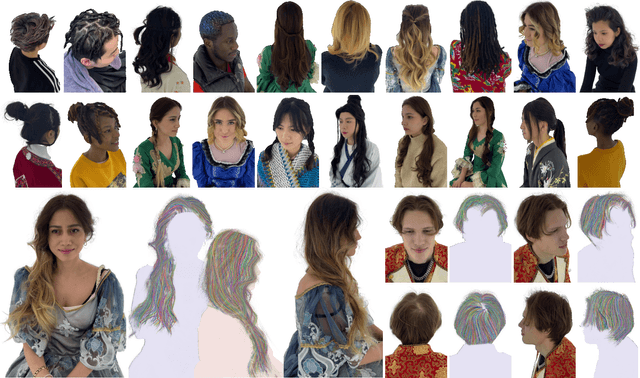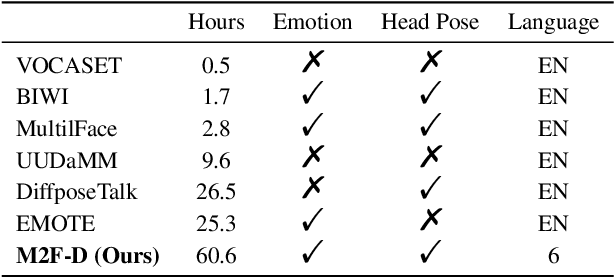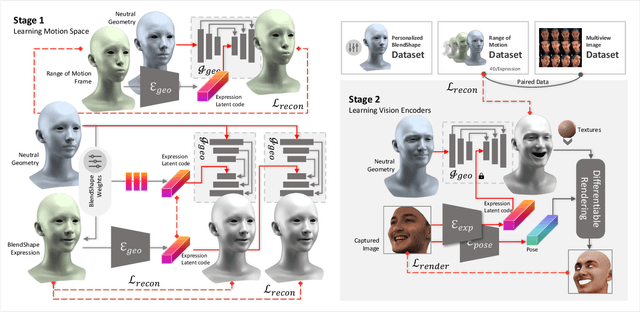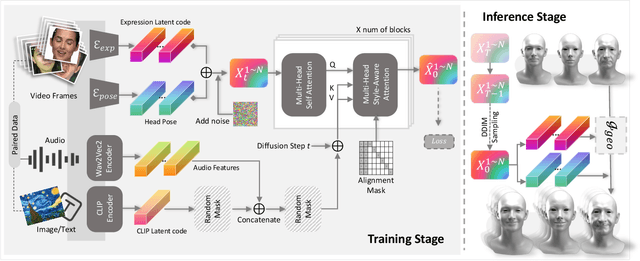Qixuan Zhang
Mojito: LLM-Aided Motion Instructor with Jitter-Reduced Inertial Tokens
Feb 22, 2025Abstract:Human bodily movements convey critical insights into action intentions and cognitive processes, yet existing multimodal systems primarily focused on understanding human motion via language, vision, and audio, which struggle to capture the dynamic forces and torques inherent in 3D motion. Inertial measurement units (IMUs) present a promising alternative, offering lightweight, wearable, and privacy-conscious motion sensing. However, processing of streaming IMU data faces challenges such as wireless transmission instability, sensor noise, and drift, limiting their utility for long-term real-time motion capture (MoCap), and more importantly, online motion analysis. To address these challenges, we introduce Mojito, an intelligent motion agent that integrates inertial sensing with large language models (LLMs) for interactive motion capture and behavioral analysis.
CAST: Component-Aligned 3D Scene Reconstruction from an RGB Image
Feb 18, 2025Abstract:Recovering high-quality 3D scenes from a single RGB image is a challenging task in computer graphics. Current methods often struggle with domain-specific limitations or low-quality object generation. To address these, we propose CAST (Component-Aligned 3D Scene Reconstruction from a Single RGB Image), a novel method for 3D scene reconstruction and recovery. CAST starts by extracting object-level 2D segmentation and relative depth information from the input image, followed by using a GPT-based model to analyze inter-object spatial relationships. This enables the understanding of how objects relate to each other within the scene, ensuring more coherent reconstruction. CAST then employs an occlusion-aware large-scale 3D generation model to independently generate each object's full geometry, using MAE and point cloud conditioning to mitigate the effects of occlusions and partial object information, ensuring accurate alignment with the source image's geometry and texture. To align each object with the scene, the alignment generation model computes the necessary transformations, allowing the generated meshes to be accurately placed and integrated into the scene's point cloud. Finally, CAST incorporates a physics-aware correction step that leverages a fine-grained relation graph to generate a constraint graph. This graph guides the optimization of object poses, ensuring physical consistency and spatial coherence. By utilizing Signed Distance Fields (SDF), the model effectively addresses issues such as occlusions, object penetration, and floating objects, ensuring that the generated scene accurately reflects real-world physical interactions. CAST can be leveraged in robotics, enabling efficient real-to-simulation workflows and providing realistic, scalable simulation environments for robotic systems.
TANGLED: Generating 3D Hair Strands from Images with Arbitrary Styles and Viewpoints
Feb 10, 2025



Abstract:Hairstyles are intricate and culturally significant with various geometries, textures, and structures. Existing text or image-guided generation methods fail to handle the richness and complexity of diverse styles. We present TANGLED, a novel approach for 3D hair strand generation that accommodates diverse image inputs across styles, viewpoints, and quantities of input views. TANGLED employs a three-step pipeline. First, our MultiHair Dataset provides 457 diverse hairstyles annotated with 74 attributes, emphasizing complex and culturally significant styles to improve model generalization. Second, we propose a diffusion framework conditioned on multi-view linearts that can capture topological cues (e.g., strand density and parting lines) while filtering out noise. By leveraging a latent diffusion model with cross-attention on lineart features, our method achieves flexible and robust 3D hair generation across diverse input conditions. Third, a parametric post-processing module enforces braid-specific constraints to maintain coherence in complex structures. This framework not only advances hairstyle realism and diversity but also enables culturally inclusive digital avatars and novel applications like sketch-based 3D strand editing for animation and augmented reality.
Visual Prompting in LLMs for Enhancing Emotion Recognition
Oct 03, 2024Abstract:Vision Large Language Models (VLLMs) are transforming the intersection of computer vision and natural language processing. Nonetheless, the potential of using visual prompts for emotion recognition in these models remains largely unexplored and untapped. Traditional methods in VLLMs struggle with spatial localization and often discard valuable global context. To address this problem, we propose a Set-of-Vision prompting (SoV) approach that enhances zero-shot emotion recognition by using spatial information, such as bounding boxes and facial landmarks, to mark targets precisely. SoV improves accuracy in face count and emotion categorization while preserving the enriched image context. Through a battery of experimentation and analysis of recent commercial or open-source VLLMs, we evaluate the SoV model's ability to comprehend facial expressions in natural environments. Our findings demonstrate the effectiveness of integrating spatial visual prompts into VLLMs for improving emotion recognition performance.
Mitigating Social Biases in Language Models through Unlearning
Jun 19, 2024Abstract:Mitigating bias in language models (LMs) has become a critical problem due to the widespread deployment of LMs. Numerous approaches revolve around data pre-processing and fine-tuning of language models, tasks that can be both time-consuming and computationally demanding. Consequently, there is a growing interest in machine unlearning techniques given their capacity to induce the forgetting of undesired behaviors of the existing pre-trained or fine-tuned models with lower computational cost. In this work, we explore two unlearning methods, (1) Partitioned Contrastive Gradient Unlearning (PCGU) applied on decoder models and (2) Negation via Task Vector, to reduce social biases in state-of-the-art and open-source LMs such as LLaMA-2 and OPT. We also implement distributed PCGU for large models. It is empirically shown, through quantitative and qualitative analyses, that negation via Task Vector method outperforms PCGU in debiasing with minimum deterioration in performance and perplexity of the models. On LLaMA-27B, negation via Task Vector reduces the bias score by 11.8%
CLAY: A Controllable Large-scale Generative Model for Creating High-quality 3D Assets
May 30, 2024



Abstract:In the realm of digital creativity, our potential to craft intricate 3D worlds from imagination is often hampered by the limitations of existing digital tools, which demand extensive expertise and efforts. To narrow this disparity, we introduce CLAY, a 3D geometry and material generator designed to effortlessly transform human imagination into intricate 3D digital structures. CLAY supports classic text or image inputs as well as 3D-aware controls from diverse primitives (multi-view images, voxels, bounding boxes, point clouds, implicit representations, etc). At its core is a large-scale generative model composed of a multi-resolution Variational Autoencoder (VAE) and a minimalistic latent Diffusion Transformer (DiT), to extract rich 3D priors directly from a diverse range of 3D geometries. Specifically, it adopts neural fields to represent continuous and complete surfaces and uses a geometry generative module with pure transformer blocks in latent space. We present a progressive training scheme to train CLAY on an ultra large 3D model dataset obtained through a carefully designed processing pipeline, resulting in a 3D native geometry generator with 1.5 billion parameters. For appearance generation, CLAY sets out to produce physically-based rendering (PBR) textures by employing a multi-view material diffusion model that can generate 2K resolution textures with diffuse, roughness, and metallic modalities. We demonstrate using CLAY for a range of controllable 3D asset creations, from sketchy conceptual designs to production ready assets with intricate details. Even first time users can easily use CLAY to bring their vivid 3D imaginations to life, unleashing unlimited creativity.
Implicit Swept Volume SDF: Enabling Continuous Collision-Free Trajectory Generation for Arbitrary Shapes
May 01, 2024



Abstract:In the field of trajectory generation for objects, ensuring continuous collision-free motion remains a huge challenge, especially for non-convex geometries and complex environments. Previous methods either oversimplify object shapes, which results in a sacrifice of feasible space or rely on discrete sampling, which suffers from the "tunnel effect". To address these limitations, we propose a novel hierarchical trajectory generation pipeline, which utilizes the Swept Volume Signed Distance Field (SVSDF) to guide trajectory optimization for Continuous Collision Avoidance (CCA). Our interdisciplinary approach, blending techniques from graphics and robotics, exhibits outstanding effectiveness in solving this problem. We formulate the computation of the SVSDF as a Generalized Semi-Infinite Programming model, and we solve for the numerical solutions at query points implicitly, thereby eliminating the need for explicit reconstruction of the surface. Our algorithm has been validated in a variety of complex scenarios and applies to robots of various dynamics, including both rigid and deformable shapes. It demonstrates exceptional universality and superior CCA performance compared to typical algorithms. The code will be released at https://github.com/ZJU-FAST-Lab/Implicit-SVSDF-Planner for the benefit of the community.
Authentic Emotion Mapping: Benchmarking Facial Expressions in Real News
Apr 21, 2024Abstract:In this paper, we present a novel benchmark for Emotion Recognition using facial landmarks extracted from realistic news videos. Traditional methods relying on RGB images are resource-intensive, whereas our approach with Facial Landmark Emotion Recognition (FLER) offers a simplified yet effective alternative. By leveraging Graph Neural Networks (GNNs) to analyze the geometric and spatial relationships of facial landmarks, our method enhances the understanding and accuracy of emotion recognition. We discuss the advancements and challenges in deep learning techniques for emotion recognition, particularly focusing on Graph Neural Networks (GNNs) and Transformers. Our experimental results demonstrate the viability and potential of our dataset as a benchmark, setting a new direction for future research in emotion recognition technologies. The codes and models are at: https://github.com/wangzhifengharrison/benchmark_real_news
GaussianHair: Hair Modeling and Rendering with Light-aware Gaussians
Feb 16, 2024



Abstract:Hairstyle reflects culture and ethnicity at first glance. In the digital era, various realistic human hairstyles are also critical to high-fidelity digital human assets for beauty and inclusivity. Yet, realistic hair modeling and real-time rendering for animation is a formidable challenge due to its sheer number of strands, complicated structures of geometry, and sophisticated interaction with light. This paper presents GaussianHair, a novel explicit hair representation. It enables comprehensive modeling of hair geometry and appearance from images, fostering innovative illumination effects and dynamic animation capabilities. At the heart of GaussianHair is the novel concept of representing each hair strand as a sequence of connected cylindrical 3D Gaussian primitives. This approach not only retains the hair's geometric structure and appearance but also allows for efficient rasterization onto a 2D image plane, facilitating differentiable volumetric rendering. We further enhance this model with the "GaussianHair Scattering Model", adept at recreating the slender structure of hair strands and accurately capturing their local diffuse color in uniform lighting. Through extensive experiments, we substantiate that GaussianHair achieves breakthroughs in both geometric and appearance fidelity, transcending the limitations encountered in state-of-the-art methods for hair reconstruction. Beyond representation, GaussianHair extends to support editing, relighting, and dynamic rendering of hair, offering seamless integration with conventional CG pipeline workflows. Complementing these advancements, we have compiled an extensive dataset of real human hair, each with meticulously detailed strand geometry, to propel further research in this field.
Media2Face: Co-speech Facial Animation Generation With Multi-Modality Guidance
Jan 30, 2024



Abstract:The synthesis of 3D facial animations from speech has garnered considerable attention. Due to the scarcity of high-quality 4D facial data and well-annotated abundant multi-modality labels, previous methods often suffer from limited realism and a lack of lexible conditioning. We address this challenge through a trilogy. We first introduce Generalized Neural Parametric Facial Asset (GNPFA), an efficient variational auto-encoder mapping facial geometry and images to a highly generalized expression latent space, decoupling expressions and identities. Then, we utilize GNPFA to extract high-quality expressions and accurate head poses from a large array of videos. This presents the M2F-D dataset, a large, diverse, and scan-level co-speech 3D facial animation dataset with well-annotated emotional and style labels. Finally, we propose Media2Face, a diffusion model in GNPFA latent space for co-speech facial animation generation, accepting rich multi-modality guidances from audio, text, and image. Extensive experiments demonstrate that our model not only achieves high fidelity in facial animation synthesis but also broadens the scope of expressiveness and style adaptability in 3D facial animation.
 Add to Chrome
Add to Chrome Add to Firefox
Add to Firefox Add to Edge
Add to Edge